A bug-out bag is a backpack filled with survival items that you should take with you when you’re bugging out, meaning you need to evacuate your home. It should have enough items plus food and some water to keep you safe and alive for at least 3 days and up to a week.
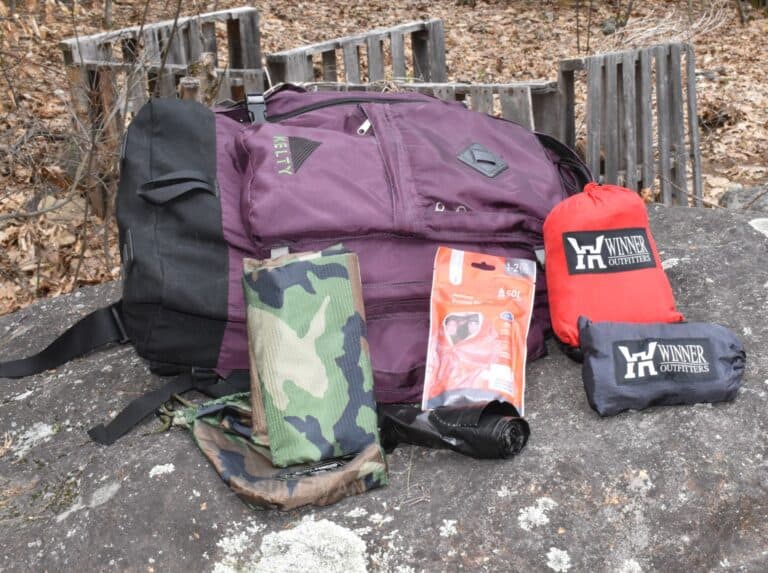
Lightweight, durable, water-resistant, and ready to fulfill all your survival needs. That’s what your bug-out bag should be like.
However, we all know packing a bug out bag is a balancing act: there are items that are crucial, and there are others that are less important, depending on your location, climate, age, and so on.
Each of our situations is unique; we all prep for different reasons and for different disaster scenarios, but most bug-out bags typically share the same items.
So what I’m going to do in this article is give you a full bug out bag list of all the things you can or should include, leaving you to decide which ones make the cut and which ones don’t.
If you’re looking for a PDF checklist that you can save offline and print, so you can tick off each item one by one, you can get it here.
But hang on for just a bit, because in this article, we’re going to delve deep, really deep, into how to build a bug-out bag from scratch.
Table of Contents
Bug Out Bag Categories Items
Click any link below to jump to the list of items in that category:
- Water and Hydration
- Food and Cooking
- Shelter, Clothing, and Warmth
- Fire-Starting
- Communications, Electronics, and Navigation
- Hygiene and Sanitation
- Tools
- Self-Defense, Hunting, and Fishing
- Medical / First Aid
- Other and Miscellaneous
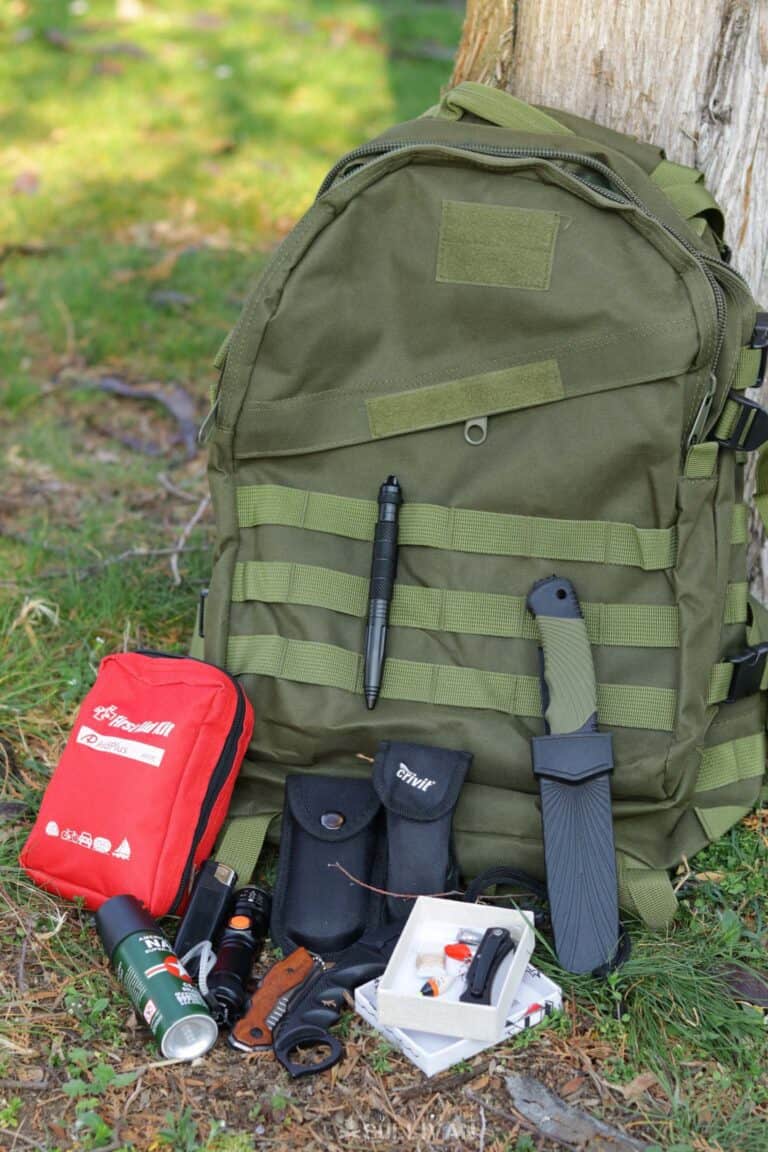
Not everything on the List is Mandatory…
Some of the items are just alternatives or backups for other items. Pick the bug out bag essentials you think you’ll need the most for your unique climate, objectives, and requirement.
Work to make sure you keep the weight of your BOB under 35 pounds. Keep in mind your fitness level, age, gender, and how far you’ll have to travel by foot, either as a primary or alternate method of travel.
Some preppers prefer more gear, others prefer a minimalist approach. What you could choose to do is have a second, smaller bag, filled with non-essentials, or use pre-packed “modules” of various items and choose to leave or take them as the situation dictates.
When disaster strikes, you’ll perhaps have time to figure out whether you can take everything you want with you or not. Even if you realize at some point that you won’t be able to carry that much weight, you can just disregard the smaller bag, maybe even cache it somewhere where you can return to at some point.
Below we’ll assess the items you should consider in categories essential to survival. Let’s begin!
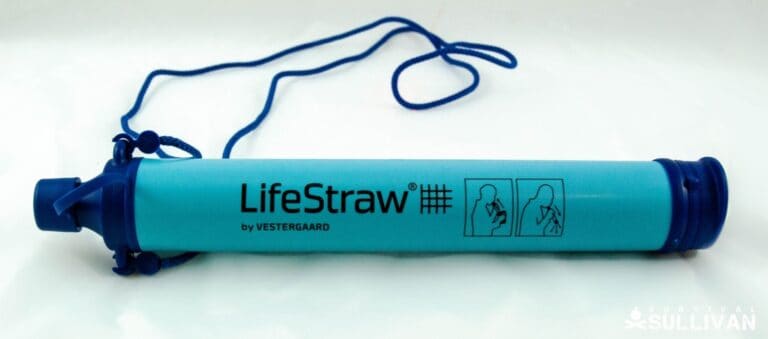
Water and Hydration
✅ #1. Water – Pay attention to how much you choose to carry on your back. Water is very heavy, and resupply should be an integral part of your plans.
✅ #2. Water Bottle, stainless steel – No paint or coatings. Get a quality one; this will allow you to cook or boil water for sanitization.
✅ #3. Water Filter – The LifeStraw is good but the Sawyer Mini filters 300-400 times more water, is half the size, and comes with a bunch of accessories. Whatever option you choose, go for one that is compact and able to draw water from a shallow supply, like a stream or puddle.
✅ #4. Water Purification Tablets – A backup method to the above item, works even on the move or in conjunction with a water filter to treat highly suspect sources. Very small and lightweight, bring plenty.
✅ #5. Cups, stainless steel – Bring two nested ones, preferably ones that will nest around your bottle or canteen. Used for supplementary cooking, gathering water from multiple drip sources, and sharing.
✅ #6. Water Bladder with tube – Excellent for drinking on the move, and holding more water conveniently compared to bottles or canteens. Keeping these clean and sanitary over time is challenging, but the benefits outweigh the drawbacks for mobility.
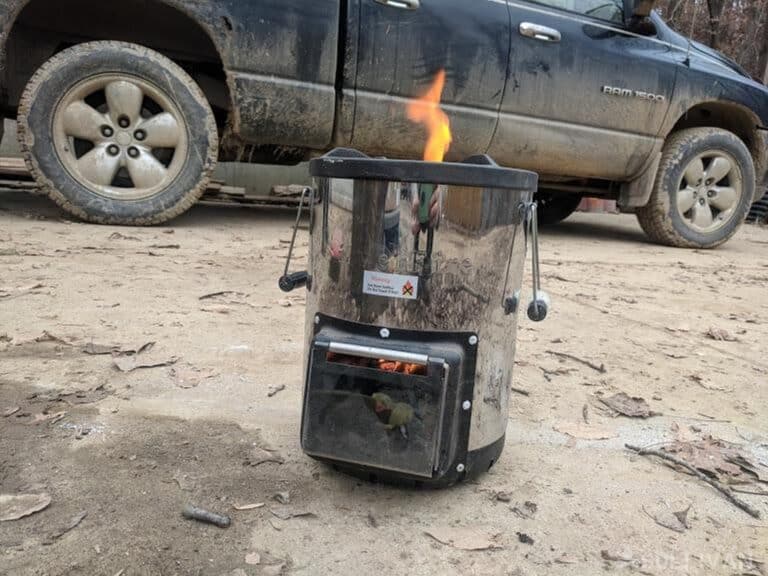
Food and Cooking
✅ #7. Hard-Tack– Lightweight and carb-dense, which you’ll need if you are being very active. Very long shelf-life.
✅ #8. Jerky – In bar or traditional form. Nothing beats animal protein for sustaining energy levels and muscle mass during periods of exertion. Choose your favorite, but don’t go overboard: the dry, salty nature of jerky will crank up thirst.
✅ #9. Freeze-dried Food – Lightweight but needs boiling water to cook properly. Good for a more substantial meal or preparing for a group. Wise Food Storage has good, available offerings.
✅ #10. Hard Candy – Preferred by some to get quick energy on the go. Pick something that won’t melt or get pulverized into dust inside your pack or pouches.
✅ #11. Energy Bars – Similar to above, useful for a pick-me-up or recharge on a break. Another option is energy gel shots, which are processed faster by the body and require less water.
✅ #12. Canned Tuna – A classic mainstay. Heavy, but calorie and nutrient dense. Goes great with your other food items like crackers and such. The leftover can be used in dire straits as a vessel for a candle, to make arrowheads or all kinds of other tasks.
✅ #13. Backpacking Stove – Keep it light, and take into account the weight and availability of fuel. Plenty of good models to choose from, pick one that will boil water the quickest for the least consumption of fuel. Great when you are worn out and need a hot meal or coffee quickly.
✅ #14. Pot Scrubber – Used to keep your metal cookery and cups clean. Helps to get any burned residue off with no fuss.
✅ #15. Vitamins – A small supply of multivitamins packed down into a baggie. You likely won’t need a whole bottle (hopefully!). these are a simple hedge against malnutrition.
✅ #16. Protein Powder – May be carried as an alternative to multivitamins as a nutritional supplement. Most are loaded with vitamins and minerals. Make sure you can stand it mixed with just water; you aren’t going to be carrying milk.
✅ #17. Spices and Seasonings – A packet of various seasonings or bouillon cubes to enhance the flavor of your meals. Great for boosting morale, or as a trade item. Do go nuts here: a small container or flat packs are ideal.
Food and Cooking – What to avoid:
❌ MREs – Expensive, crazy-high sodium, can cause constipation if eaten regularly. They do benefit from sturdy packaging and excellent preservation. Best used broken down to supplement other rations.
❌ Mason-Jarred Food – Too heavy and fragile. I don’t care how tasty your rhubarb preserves are, leave them in the pantry!
❌ Pop Tarts – Too little nutritional value, and impossible to keep intact outside of a hard container. Can take the place of candy, but usually not worth the trouble.
Shelter, Clothing, and Warmth
✅ #18. Hiking Boots – Kept with or attached to your BOB. Assuming you aren’t wearing them when you light out, you’ll change into them as the situation dictates. Ensure they are trail-tested and broken in before you need them!
✅ #19. Poncho – Used for keeping rain off of your body on the go, or as a small shelter. Choose a good one with excellent rain and tear resistance. Make sure it has a generous hood.
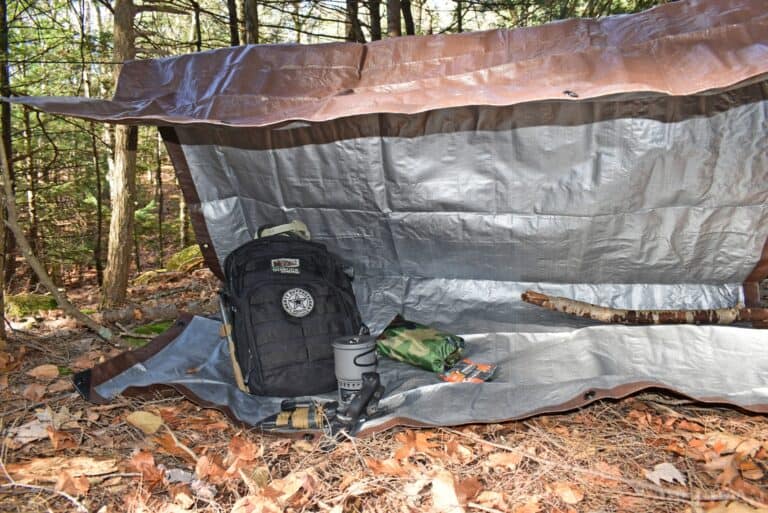
✅ #20. Tent – A lightweight, simple tent setup to serve your group, if applicable. It is easy to go overboard here: tents can get heavy and gobble up a lot of room.
✅ #21. Tarp – A high-quality tarp with sturdy grommets can serve a variety of purposes, taking the place of a tent, acting as a ground cover, privacy screen, and more.
A reversible type with camo on one side and a high-vis color for signaling is a good idea and will improve versatility even more.
✅ #22. Sleeping Bag with pad – Chosen according to climate and weather endemic to your locale. Go for as light and compact as possible. Carriage will necessarily be strapped to the outside of your BOB, so work out the details beforehand to ensure you will not be overly unbalanced.
✅ #23. Pants – Modern materials are best here. Avoid heavy mainstays like denim or canvas that are slow to dry.
Go for a technical garment that is light, flexible, and quick drying. Extremely cold climates will require something different.
✅ #24. Shorts – In very warm climates, shorts make sense. Choose material according to climate.
✅ #25. Socks – Bring several pairs. Thick, genuine wool plus thinner ones. You can layer them based on insulation and padding needs, and rotate them regularly. Take care of your feet!
✅ #26. Thermal Underwear – In very cold climates, long johns are invaluable and add almost no bulk or weight. Don’t forget an extra set of bottoms if you aren’t wearing skivvies underneath.
✅ #27. Blanket – A small, packable camping blanket. Used for additional insulation on quick stops as well as sleeping. Sturdy blends can be used as a ground cover.
✅ #28. Emergency Blanket – The silver, space type. Used for warmth as designed, and can also reflect a ton of heat off of a fire to maximize warmth in a shelter. Ultra-light and takes up next to no room, but take care that it does not get punctured.
✅ #29. Gloves – Mandatory for protecting your hands from all sorts of mishaps and sharp or rough surfaces. Select gloves based on requirements: a heavy leather pair offers unparalleled protection but makes delicate tasks or running guns very difficult.
Light, technical gloves are good for dexterity but offer less protection. You may consider a pair of each, nested inside one another to cover your bases.
✅ #30. Footwear (in addition to hikers) – If you can spare the weight, a backup pair of hiking shoes or boots will ensure you stay mobile while waiting on a pair to dry out or furnish a replacement if your primaries get damaged.
✅ #31. T-shirts – A couple of fresh shirts will help you stay clean and avoid rashes and other ailments from soiled clothing. Don’t underestimate the value of a fresh set of clothing.
✅ #32. Bandannas – Useful for keeping the sun off your head, face, and neck, mopping sweat, as impromptu dressings and countless other mundane tasks. Can also pull duty for signaling, or being tied into a small sack or bindle.
✅ #33. Sunglasses –Take care of your peepers! Glare will seriously degrade your vision over time. Quality specialist tints also allow you better contrast in shady or bright light conditions. You can get more protection out of your shades by choosing lenses that are ANSI or Mil-Std. rated against impact and shattering.
✅ #34. Jacket or Coat – Nighttime temps almost anywhere in the world can fall low enough to make hypothermia from exposure, especially when wet, a real threat. If there is any chance you’ll be outside anywhere but the hottest climates bring an insulating outerwear top.
✅ #35. Extra prescription or reading glasses/ contacts – If you cannot get by without them, you can’t get by without them. Bring what you must have to prosper. Two is one, one is none.
Shelter, Clothing, and Warmth – What to avoid:
❌ Pajamas – This isn’t a slumber party. You’ll be sleeping in your traveling clothes, any redundant articles of clothing must be spares, not niceties.
❌ Umbrella – Serves only one purpose, and can only do that well in wide open spaces. Leave it at home and use your poncho.
❌ Too Much Clothing – You aren’t traveling for pleasure. Clothes eat up space that comes at a great cost. Face it: you are going to get dirty, and smelly, and not be washing your clothes too often. Take only what you need to take care of your body and survive.
Fire-Starting
✅ #36. Matches, waterproof – Accept no substitutes. Too small and light to not have a small bundle. You can keep them stashed anywhere, and so long as their protective coating is in place they will be ready to light in wet weather.
✅ #37. Lighters – At least 2. The other fire-starting items we have on the list are great and you should be proficient with them, but for convenience and efficacy, nothing beats a lighter.
The classic Bic is a fine choice and will work in anything except truly freezing conditions.
Think carefully before choosing a classic Zippo or similar: they constantly lose fuel, which means you have to carry more for long excursions, and their adaptability to various improvised fuel sources does not outweigh the reliability of modern lighters most of the time.
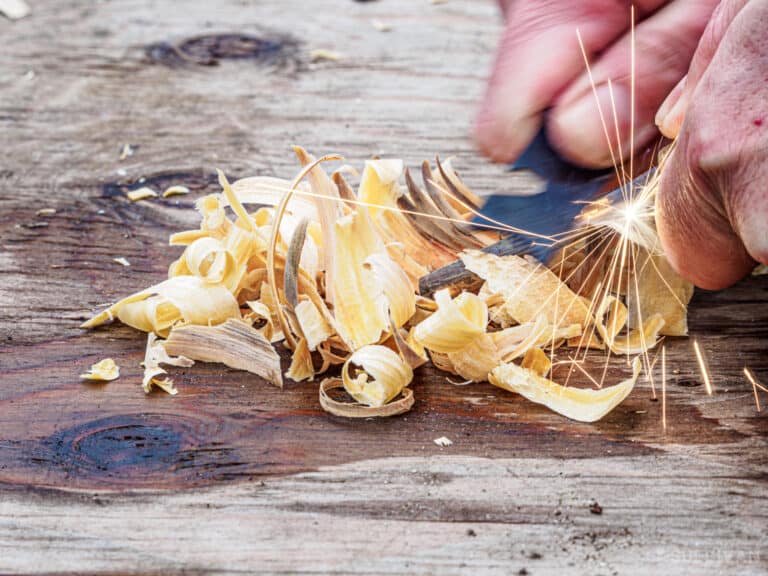
✅ #38. Ferro Rod – Used with steel tool or striker to create a shower of screaming hot sparks. Small and light, good to have as a backup fire-starting method. Does not run out of fuel, so to speak, and can be used in the coldest temperatures with ease.
✅ #39. Magnesium Fire Starter – Bought as a kit with a Ferro rod or separately, magnesium flakes when ignited burn furiously, and make starting a fire with tinder easy.
A tiny bar with an attached scraper is a typical configuration. May be used in conjunction with other methods.
✅ #40. Tinder – Keep char cloth, Vaseline-soaked cotton, dryer lint, dry shavings, or anything else in a well-sealed container or bag. Tinder is important to ensure you can start a fire using larger fuel wood effectively.
✅ #41. Aluminum Foil – For cooking and fire starting. You can carefully foil it into a cigar-sized tube, taking care to leave one end open, and then fill it with slow-burning fuel. Once done and lit, it can burn down into coal that you can safely preserve and move using the foil tube.
✅ #42. Fresnel Lens – A compact lens designed to focus the sun’s rays into a tiny spot with the intent of starting a fire. Obviously only viable on sunny days, but is small, and can be used as a magnifying glass.
Fire-Starting – What to Avoid:
❌ Standard Matches – Flimsy barbecue or matchbook matches are useless when wet and fragile. One errant spill or dunk into water and they’re useless. Don’t bring these unless you have no other choice.
Light
✅ #43. Headlamp – Terrific when on the move or when you need to go hands-free and don’t want to hold a flashlight in your teeth.
You don’t need extremely high output for this; focus on comfort and long run time. Additional color LEDs or modes may be beneficial.
✅ #44. Flashlight, battery-powered – Humans are no good in the dark thanks to our pitiful night vision. Select a model with high output and solid runtime. Don’t forget the weight of the batteries. Will be used for illumination indoors and out, signaling, and identification of possible threats.
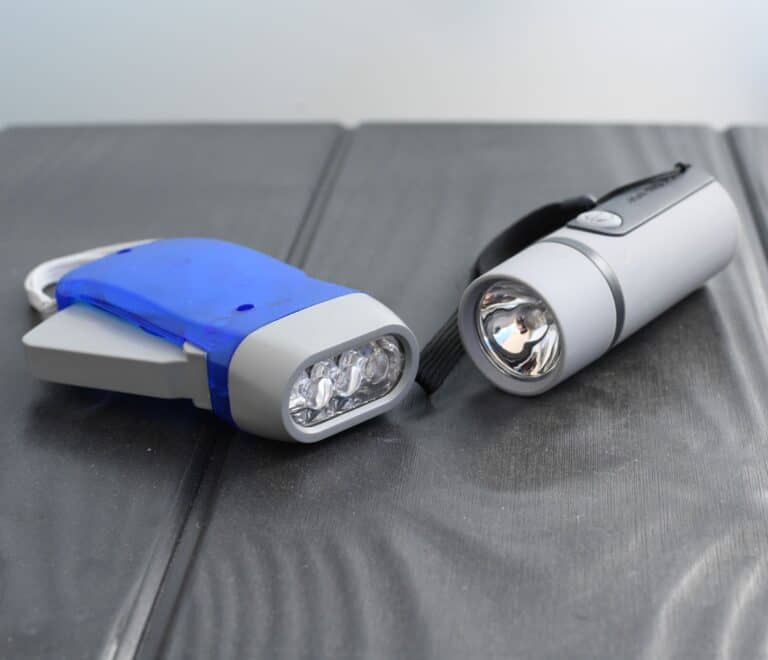
✅ #45. Flashlight, crank powered- For backup and long-duration events. As long as you have muscles you can keep the lights on. Efficiency and durability vary greatly with quality. Do your homework before purchasing. Some are little more than novelties.
✅ #46. Solar Charger – Thanks to advances in design and manufacturing, these gadgets are more affordable than ever. Can charge anything that they are rated for, typically via a USB outlet. A must-have if you are dependent on any electronics like smartphones, GPS, tablets, and such.
✅ #47. Chemlights – An often overlooked source of heatless, flameless, safe light. Work well for marking, signaling, and general illumination. Beware of cheap party-favor lights. Stick to the mil-spec kind. Note that different colors vary in their lifespan.
✅ #48. Candles – Proper survival candles are surprisingly compact and burn for a very long time. Used obviously for light, but can be used for heating if employed with caution.
Lighting – What to Avoid:
❌ Lantern – Whether battery or liquid-fueled, these are too big and bulky for what they offer. Keep them in the vehicle or your INCH bag instead.
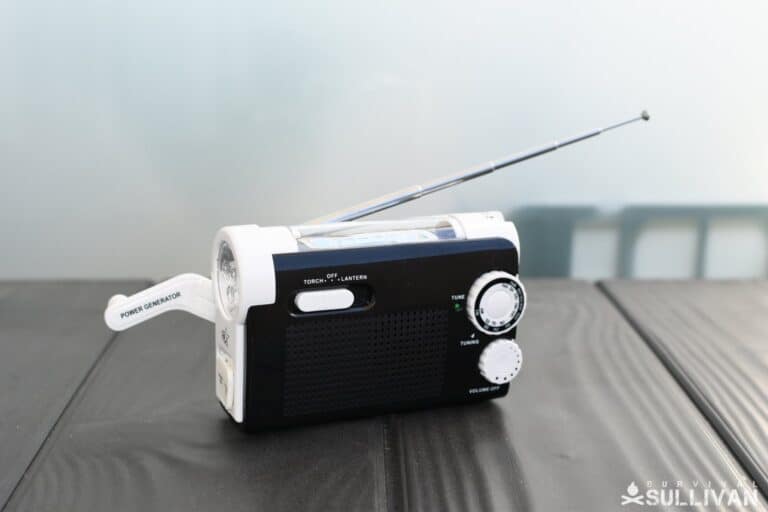
Communications, Electronics, and Navigation
✅ #49. Notebook and Pen/Pencil – For taking notes, leaving messages, sketching, and last-ditch tinder. Get a type of paper that is waterproof and pair it with an indelible ink pen to ensure the elements won’t affect your writing.
✅ #50. Emergency AM/FM Radio, hand-cranked – Invaluable to keep up to date on developing disasters or crisis situations.
You won’t be leaving this on all the time, so the hand-crank power supply means you’ll save weight and space on batteries besides not running out of juice till you do! Some nicer models even have a charging port built in for USBs or 12v adapters.
✅ #51. Cell phone or smartphone – Use with a prepaid calling card. If you have a signal and the networks are still functional, nothing beats a cell phone for convenience and speed of communication.
Be sure to harden it with a specialty case or keep it in a heavy-duty plastic baggie.
✅ #52. Spare phone battery – Phones gobble batteries, especially smartphones. If you make it a point to keep a charged spare with it, you can drastically extend the time you can make use of either calling or apps between recharges.
✅ #53. Ham Radio – If you know how to use it, the capability of a portable radio is invaluable for both communications and info gathering.
Note that they are not plug-and-play: a certain level of skill is required, and they are power-hungry. If you are willing to invest the time to utilize them, consider it. If not look at a…
✅ #54. Walkie-Talkie – Great for maintaining communications with another member of your party, or another group within short distances. Quality and performance vary wildly with price. Don’t cheap out. Take time to ascertain limitations before committing to carrying one.
✅ #55. GPS – Absolutely lifesaving, if they have signal and power. Makes pathfinding and navigation trivial with a little practice. Another power-hungry tool. Ensure you have spare batteries or a charging solution.
✅ #56. Earbuds – Useful to keep noise to a minimum when on the phone or listening to prompts from one of the above devices.
Try to choose a decent pair with good reviews for ruggedness and heavy-duty cables. Ear-pieces should fit snugly, or else they will constantly be coming loose from movement and sweat.
✅ #57. Whistle – Another time-honored emergency signaling tool, a whistle can also be used for rudimentary communication using Morse code or pre-arranged signals with another member of your group. Be sure to pick a model that is very loud, and reasonably durable.
✅ #58. Signaling Mirror – Enables you to use the sun in a different way by directing a brightly conspicuous flash over a long distance. Most have a rudimentary hole or notch to be used as a sight. These take some practice to use well, but do work. Also handy for shaving.
✅ #59. Compass – Whether a button or field compass, make sure it is a quality model and calibrated for the hemisphere of the world you are in. Aside from the most basic direction finding, this will do you little good without the knowledge of land navigation and a suitable map to go with it.
✅ #60. Topographic Maps – Specific to the area you are in. Make sure they are up-to-date and waterproof. The old-fashioned silk survival maps are becoming available again, and are durable.
Hygiene and Sanitation
✅ #61. Toilet Paper – For when nature calls. Keep it in a waterproof container. If it gets wet ahead of nature’s call, it will be nearly useless.
✅ #62. Hand Sanitizer – Used after cooking, cleaning, nature’s call, or exposure to other biohazards. The variety of communicable diseases and germs you’ll be exposed to during a long-term SHTF incident will be horrifying. Use this to keep from catching or spreading them.
✅ #63. Wet Wipes – For basic hygiene and cleanliness. They don’t replace bathing but will extend the time you can go between baths greatly.
✅ #64. Toothbrush – Break off the handle to save space. Keeping your teeth in good condition is paramount. Tooth decay, aside from being extremely painful, can lead to life-threatening infections. Take care of your chompers!
✅ #65. Toothpaste – Used obviously with above. Most paste varieties also make a decent metal polish.
✅ #66. Floss – Aside from oral care, most flosses make for fine, strong cordage, suitable for fishing, lashing, sewing and numerous other tasks. A small roll weighs almost nothing and can be removed from its plastic carton to save even more space.
✅ #67. Comb – Combing your hair helps it stay healthy, and helps you feel your best. The tiny tines of a comb can also be broken off to form “gorge hooks” for fishing.
✅ #68. Shampoo – If you have time and opportunity, shampoo will do the trick for your hair and body when bathing. Also makes for good trade fodder.
✅ #69. Nail Clippers – Another basic element of hygiene. Sure, you can tear or bite your nails short, but aside from being nasty, it makes your nails weaker. Use clippers to keep them short, clean, and strong.
✅ #70. Feminine Hygiene Products – Only if required.
✅ #71. Bar Soap – Used for bathing. If left to dry for a short time can be packed away again with no risk of nasty spill inside your pack.
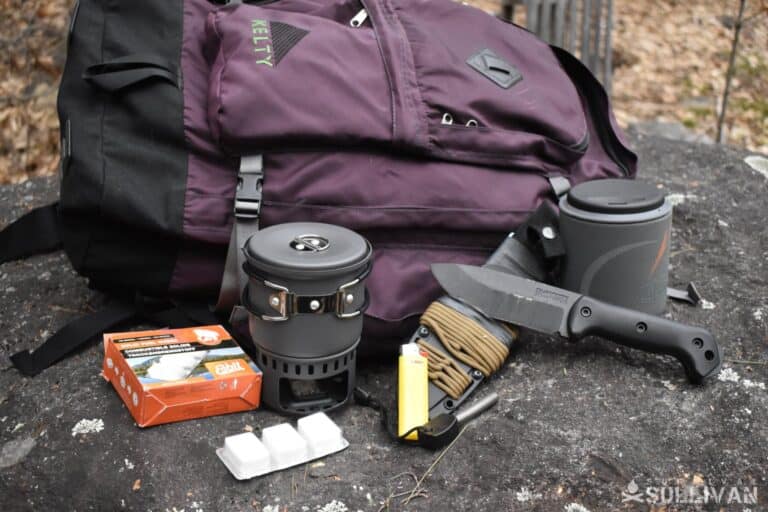
Tools
✅ #72. Knife, fixed blade – A good bushcraft knife is essential for any survival scenario: processing wood, cutting cordage, defense, the list is endless. A beefy fixed is desired for durability and resistance to abuse, especially for batoning of wood.
✅ #73. Backup Knife – Similar to above. In the event of loss or breakage, this will save the day. You may choose a duplicate of your above knife or a smaller, but still capable model.
✅ #74. Multi-Tool – A multi-tool will allow you to have the most commonly used tools in a small package.
While not the strongest or most efficient, the space savings are considerable. Like everything else on this list, buy quality. Leatherman, Gerber, SOG, and Victorinox all make good models.
✅ #75. Pocket Knife – A small pocket knife is great for detail work where your large bush knife would be too imprecise. Also serves as a backup knife in the event your main blade is lost or broken.
✅ #76. Pry Bar – A solid pry bar, while heavy, can help you move or shift heavy objects, access locked or barricaded containers and doors, and also serve as a bludgeon. This will have the most utility for urban dwellers vs. rural preppers.
✅ #77. Hatchet or Camp Axe – The hands-down best tool for felling small trees or saplings and processing them.
Not as versatile as a knife, but if you are living in a heavily forested area you should consider carrying one. Also makes for a potent close-quarters weapon.
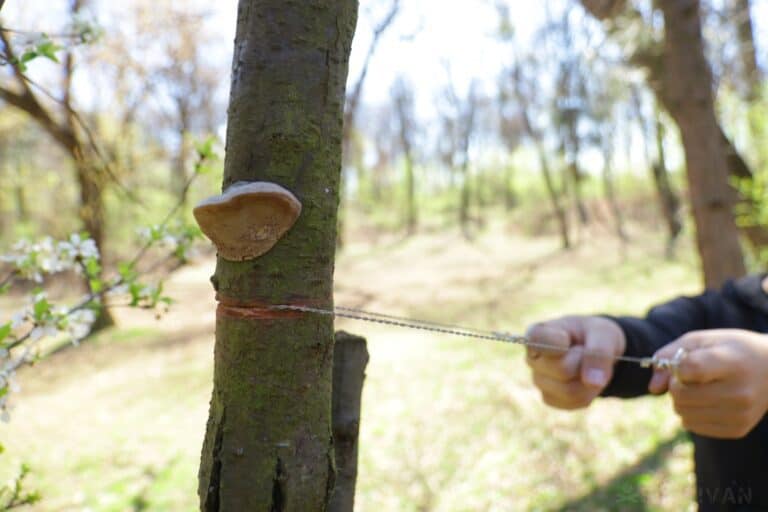
✅ #78. Wire Saw – This manual “chainsaw” takes up far less room and weight than a hatchet or axe, but can be used to saw through limbs and smaller trees in good order. Not useful for splitting.
✅ #79. Small Hammer and Nails – For quickly assembling wood into something resembling a dwelling, nailing is ideal. Lashing with cordage is fine, but can be time-consuming. A small carpenter’s hammer will work best, but you could also use your hatchet if it has a hammer poll.
✅ #80. E-Tool / Folding Shovel – The classic military entrenching tool, whatever guise it comes in, is strong and compact enough to get consideration for any BOB.
Sometimes you need to dig, be it for fire, concealment, shelter, sanitation, or extrication, and when the time comes a shovel will make short work of it. You can ad-hoc it with another tool, but you risk damaging it and yourself.
Self-Defense, Hunting, and Fishing
✅ #81. Gun and Ammo – Pistol, rifle, or shotgun, a firearm will serve as your best means of defense from two- and four-legged critters, as well as your primary game-getter.
Make sure it is reliable, clean, and oiled and you know how to use it. Shotguns offer the most versatility, but their ammo is by far the bulkiest and heaviest.
✅ #82. Gun Cleaning Kit – Depending on the length of your anticipated excursion, this could be a multi-section rod with a few patches and bottles of oil or a more complete gun care kit with spare parts.
Having a reserve of quality gun oil is most important, as many guns will chug along happily dirty so long as they stay oiled.
✅ #83. Body Armor – Depending on your personal scenario, this may be on your body before you set out.
Selection requires careful analysis of anticipation and likelihood of threats: armor is heavy, hot and cumbersome, especially hard armor that will defeat rifle rounds.
If in a rural or remote location, mobility and concealment are probably better defenses.
✅ #84. Pepper Spray – Pepper spray will serve as your intermediate force option against both animals and people. Essential for urban dwellers or anyone who may be moving to or through unknown concentrations of people.
While not 100% effective (what is?) it will give any would-be assailant a strong incentive to desist, or severely degrade their vision if they don’t. Buy a quality, police-grade brand.
✅ #85. Bug Repellant – Mandatory for any coastal or heavily wooded areas, and generally a good idea for all.
Mosquitoes, ticks, biting flies, and more all hunger for your blood, and aside from being profoundly irritating their bites may transmit debilitating diseases. Have it on you, and reapply at the manufacturer’s recommended intervals.
✅ #86. Slingshot – An ancient but effective weapon, a modern slingshot loaded with ball-bearing ammunition is no toy.
Able to take small game easily with a good shot, it might serve you well as a nearly silent hunting tool. Note that like all weapons this will require considerable practice to use effectively. Practice before the SHTF.
✅ #87. Machete – For moving through the densest foliage, machetes are used in cultures around the world. A good machete will let you do the same, as well as serve you as a brutal slashing weapon.
Machetes will be of heavier or lighter build depending on the intended technique, and heavier ones may handle tasks like splitting and batoning more similarly to a bush knife or axe.
Disclosure: This post has links to 3rd party websites, so I may get a commission if you buy through those links. Survival Sullivan is a participant in the Amazon Services LLC Associates Program. As an Amazon Associate, I earn from qualifying purchases. See my full disclosure for more.
✅ #88. Fishing/Hunting Vest – A cargo vest of some type will let you keep all your often-used equipment close at hand and easily accessible without having to don and doff your pack every time you need something.
This can range from the larger “photog” vest to a minimalist chest rig. Whichever you choose, don’t treat the added room as a license to pack on even more equipment: Ounces make pounds, and pounds make pain.
✅ #89. Bow and Arrows – For those that have the skills to use it a bow makes a fine hunting weapon, being nearly silent, capable of using a variety of heads for different tasks, and being adaptable to primitive, homemade ammunition.
This is another item that will do you no good if you do not already have the know-how: if you aren’t practiced, leave it at home.
✅ #90. Fishing Rod and Hooks – If you will be traveling through an area with bodies of water well populated by fish, a proper, if spartan, fishing rig is a great choice to provide a steady supply of high-quality protein.
A little know-how goes a long way, so pack your lures and things according to the anticipated species you’ll try to catch.
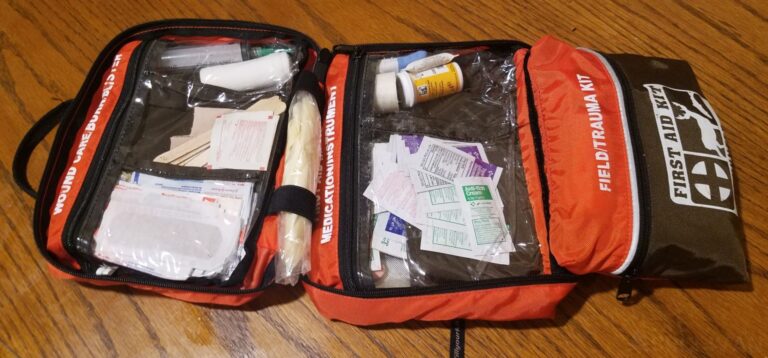
Medical / First Aid
✅ #91. First-Aid Kit, basic – This kit should be small and contain all of the things needed to treat lesser ailments and injuries, think bumps, scrapes, small cuts, and minor burns.
Included should be band-aids, antiseptic swabs, ointments, burn relief products, and doses of meds for things like headaches, allergies, etc.
✅ #92. Suturing Kit – If you sustain a bad laceration in a remote place, or one where there is no medical assistance coming, you’ll need to suture it.
A suturing kit uses specialized needles, thread, and forceps to close up wounds strongly, promoting healing and keeping foreign material out. Learn how to use it before you take it, but there is something to be said for having it handy in case you run into someone else that can make use of it.
✅ #93. CPR Mask – Gives you a safe, repeatable, no-contact seal with a victim undergoing CPR. Bulky, but an important part of any well-stocked medical kit.
✅ #94. Respirator Mask, N95, or N99 – A breather mask rated for dust, vapor, and some biological compounds is invaluable in the event you are moving through an area with either disease, chemical, or smoke/dust atmospheric contamination.
This weighs almost nothing and newer disposable ones can pack down flat, though the classic mask and cartridges is still an option.
✅ #95. Painkillers – High-test painkillers for grievous injuries. Sometimes the worst happens to you or someone else, and these will be needed both to calm them down and make them pliable enough for proper treatment. Know what you are doing before stocking or administering these.
✅ #96. Styptic Powder – This powder reacts with blood to staunch bleeding. Typically painful, but useful to stop weeping injuries that do not warrant suturing, or ones to very vascular areas like the head, face, or hands.
✅ #97. Arm Sling – Not for long gun, but the kind that immobilizes a broken or badly sprained arm. Sure, you can fashion one from whatever cravat, cloth, or neckerchief is handy, but you’ll save a lot of pain and grief from having the purpose-made solution handy. No pun intended…
✅ #98. Thermometer – The onset of a bad fever is no time for folksy measurement or analysis.
Having an accurate thermometer can let you track the progress of the fever, helping you determine both when to administer medicines and their effectiveness as well as when to seek serious medical aid.
✅ #99. Antibiotic Ointment – In a survival situation, any cut or scrape can be a vector for infection, and must be treated accordingly. A simple band-aid and antibiotic ointment will serve as the vanguard against infection. Keep a tube in your basic first-aid kit.
✅ #100. Hand and Body Warmers – Aside from their obvious morale-boosting benefits, strategically placed warmers along with good attire may very well save your life if you are caught without adequate shelter. Hand warmers alone in pockets or a pouch will keep your blood warm and fingers dexterous in bitingly cold conditions.
✅ #101. Baby Powder – Very helpful in controlling moisture, especially in humid climates.
Dampness against your body when combined with a lack of airflow and heat will turn into a breeding ground for fungus, bacteria, and more.
Think under the arms, crotch, feet etc. Powder combined with the rotation of clothing will go a long way to keeping you rash and rot-free!
✅ #102. Laxative – An odd diet, consisting of novel proteins or one of predominately processed food and stress can lead to pretty severe constipation.
While not a problem in the very short term, it can cause issues if not corrected. A few doses of laxatives in your first-aid kit can prevent this often underestimated ailment.
✅ #103. Gauze Pads – Necessary for packing penetrating wounds as well as treating shallow lacerations. Take a variety of sizes to suit the task or just a roll of thick gauze.
✅ #104. Tourniquet – Tourniquets stop bleeding in the extremities, one of the most common and most preventable forms of ex-sanguinations.
There are a variety of types on the market. Not all of them are good. Know what’s what, and learn how to apply it to yourself and others. Bring a couple.
✅ #105. Knee Brace – If your knees are weak, be it from age, old injury or whatever, a knee brace may not be a bad idea to include in your kit.
You must assume you will have to walk at some point to save your skin, and if your knee starts a countdown to giving out on you it may spell disaster.
A knee brace in such a scenario will both extend your range and minimize pain and damage.
✅ #106. Aspirin – Aspirin is no longer the wonder drug it once was, but is still a valuable addition to your medi-kit, being able to ease pain and even help with heart attacks. Bring high and low doses.
✅ #107.Medical Tape – Mandatory for securing bandages, dressings, and more. A roll takes up little space and weighs almost nothing.
✅ #108. EMT/Trauma Shears – If you need to cut off clothing, webbing, or footwear to access an injury these are your best bet. There are some situations where swelling or other considerations make simple removal of clothing impossible.
✅ #109. Benadryl – For treating simple allergies and serious allergic reactions. A strong dose can punch out a reaction before it takes hold, but beware: it will make you very drowsy.
✅ #110. Medical Gloves – High-quality latex or nitrile gloves will let you perform injury care without exposing yourself to blood-borne pathogens. Also handy for any other task where your hands could be contaminated with oily or noxious substances.
✅ #111. Scissors – Simple, sharp scissors have a variety of uses, and will be handy where the beefy trauma shears are too imprecise. Be sure you have a method to carry them safely, as they will typically lack the blunt tips of the shears.
✅ #112. Antibiotics – You’ll need to get these from an understanding doctor; inform them of what you are anticipating doing, and let them guide you in selection and quantity. When infection sets in, these may well spell the difference between life and death.
✅ #113. Aspercream – Sometimes you have a stitch or other muscle ache that is persistent. Aspercream and similar ointments can help you cope with the pain and aid recovery.
✅ #114. Abdominal Pads – For treatment of large wounds or wounds that excrete fluid heavily, abdominal, or ABD, pads are he go-to. These are designed to absorb and wick fluid away from the wound site.
✅ #115. Potassium Iodide – In the event of a radiological threat, be it a power plant meltdown, nuclear strike, fallout will present a major hazard. Potassium iodide will protect you against ingestion by blocking its uptake in the thyroid gland.
✅ #116. Tylenol – A time-honored, safe, and reliable pain reliever. Have some on hand in large and small doses.
✅ #117. Tweezers – Most valuable for the extraction of splinters, metal fragments, and other tiny but painful shrapnel. Get a good pair made of quality steel that will allow sterilization.
✅ #118. Band-aids – All shapes and sizes. As mentioned above, even a small cut could be deadly if it becomes infected. The chances that you will be exposed to novel germs in an SHTF scenario are very high. Take no chances.
Other and Miscellaneous
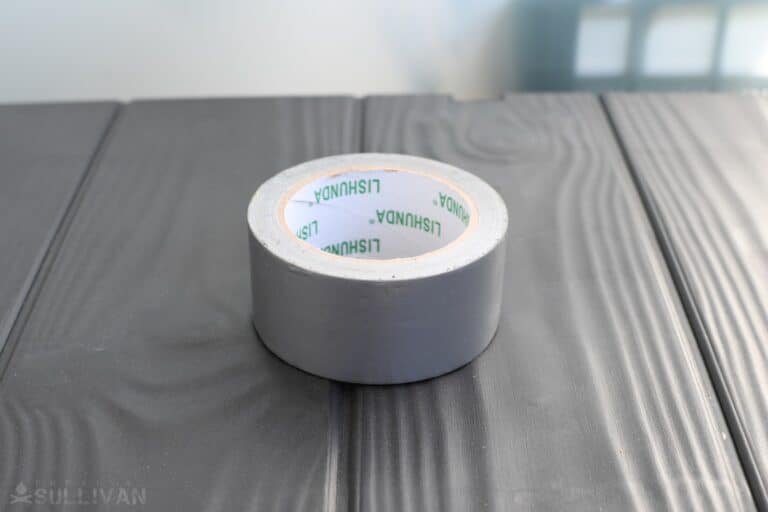
✅ #119. Duct Tape / Gorilla Tape – Come on, you knew you weren’t going to make it out of here without seeing this, didn’t you? Duct tape’s uses are limited only by your imagination and has had whole books written about it.
It can be used to repair, bind, seal, attach, and more. You can include the giant roll if you want, but you can also wrap it around a small stick or something similar to make it easier to transport.
✅ #120. Paracord – Every prepper’s best friend (besides duct tape). Paracord is immensely strong for its size and can be used for everything from shelter to trapping and more.
✅ #121. IDs and Documents –Make copies of all your important IDs and other documents, either paper or on a flash drive, and take them with you. If on a flash drive, ensure they are encrypted and key protected. Think things like mortgages, wills, banking info, deeds, etc.
✅ #122. Sunscreen – Sunburns can be merely annoying to outright debilitating.
Clothing will go a long way toward protecting you, but unless you are wrapped up like a mummy there will always be parts of your body exposed. Sunscreen will protect your exposed skin, even if it’s just your neck, face, and hands.
✅ #123. Paper Clips – Sturdy paperclips can be fashioned into lockpicks, trap triggers, fishing hooks, and more. Throw a few in with your small tools.
✅ #124. Elastic Bands – Useful for rigging straps, poles, and the like, but also work for trap construction. Make sure they are sturdy enough to withstand the elements and repeated applications.
✅ #125. Trash Bags – Numerous uses, from sanitation, solar stills, water storage to containing wet or dirty clothes, boots, etc. Make sure they have quality seams and won’t leak.
✅ #126. Ziploc Bags – Same as above, only smaller. Ziploc brand bags have excellent closures and work well for holding water, waste or merely compartmentalizing your supplies in your pack.
✅ #127. Extra Keys – For home or vehicle. For when you lose your primary pair, or need to hand off a set to a family member.
✅ #128. Mosquito Netting – Stopping or sleeping in an area infested with mosquitoes without one of these will teach you what aggravation is.
Make sure you have one with extremely fine mesh, as other jerk-biting insects like no-see-ums and other tiny flies can get through the average mosquito net.
✅ #129. Compressed Sponge – A sponge can be a useful item for wicking up water from surfaces that are unexploitable any other way. Keep it dry and tightly bound and it takes up almost no weight or space.
Controversial / Non-Essential Items
We all have our own ideas on what a bug-out bag should contain and sometimes it’s best to agree to disagree. That’s why I decided to make a separate list of the non-essential items, the ones that may be important for some but not for others.
#130. E-Reader or Tablet – An E-reader is a unique addition to your BOB packing list for several reasons.
It uses very little energy and can hold literally thousands of survival texts and manuals. You can turn off WiFi to prevent tracking as well as save battery life.
You should be worried about the fact that a little water or an EMP event can render it useless. To protect against water you can install it into a special water-tight case.
or an EMP, you could put it in a Faraday cage. Faraday cages are themselves contentious because while everyone seems to know how to make one, no one knows if they will actually work.
#131. Compact Digital Camera – There are a couple of things you can do with a digital camera. First, you can take photos every mile or so to find your way back if you get lost.
Second, you can use the zoom function to take a better look at things/people. Of course, you can also use binoculars or a monocular for that.
Comfort Items and Foods
There are always those few things that some folks just will not be happy without. Some people will want them, others won’t. It’s up to you whether you want to carry them.
#132. Bottle of Liquor – More than just for relaxation, liquors make great trading goods and serve as icebreakers and social lubricants. Powerful assets when you are an unknown around new people.
#133. Cigarettes/Tobacco – Same as above. Can help you relax or make friends.
#134. Chocolate – A luxury item until very recently in human history. More importantly, it is beloved by children the world over and makes for good bait for all manner of rodents. Keeping it intact and unmelted is often an exercise in frustration, however.
#135. Coffee or Tea – Some people just cannot give up their morning or evening cup. A great pick-me-up, and easy to carry. Also has strong bonding connotations.
#136. Condoms – It may seem odd to have these in one’s BOB, but consider their many uses. You can use them to carry water, keep your long gun’s muzzle from filling with water or dirt, and more.
Which of These Items Are Right for You?
As i said, you can’t pack everything on this list. if you do, you’d end up with a very heavy bug-out bag! There are a few tricks to know whether or not you should pack a survival item:
- Pick one or the other from the same category. For example, don’t pack coffee and tea, choose the one you like best.
- Consider your climate. Don’t pack winter clothing if you live in Texas – you won’t need it!
- Does that particular item fit with your survival plan? For example, don’t pack potassium iodide if you’re not prepping for nuclear fallout.
- Do you know how to use this item? For instance, you may want to skip on packing fish hooks if you don’t know how to fish.
M. I. Grey’s BOB Items
Here are some items one of our authors has in his bug-out bag…
You can see below: a solid survival knife, a portable camping stove, fuel cubes fire starters, several ways to start a fire, and more.
As you can probably notice, he’s truly prepared when it comes to hydration. He has both a Lifestraw and a Sawyer Mini, AquaTabs, energy drink, and some powdered drink mixes:
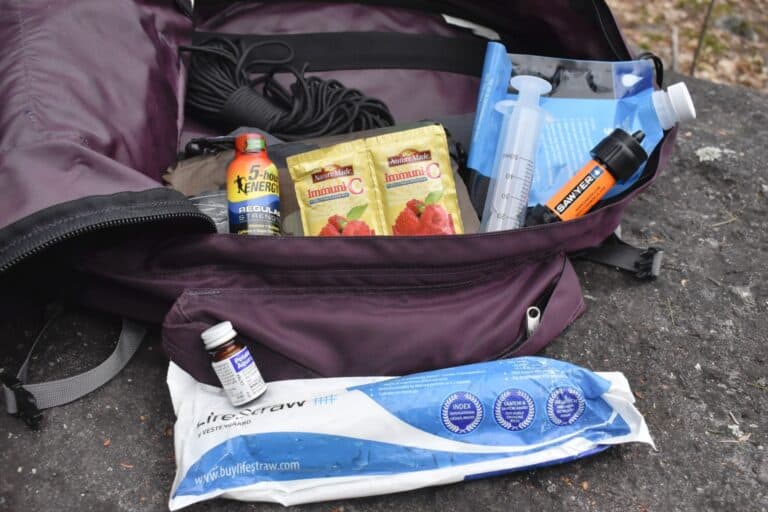
He’s very well covered on the communications front as well:
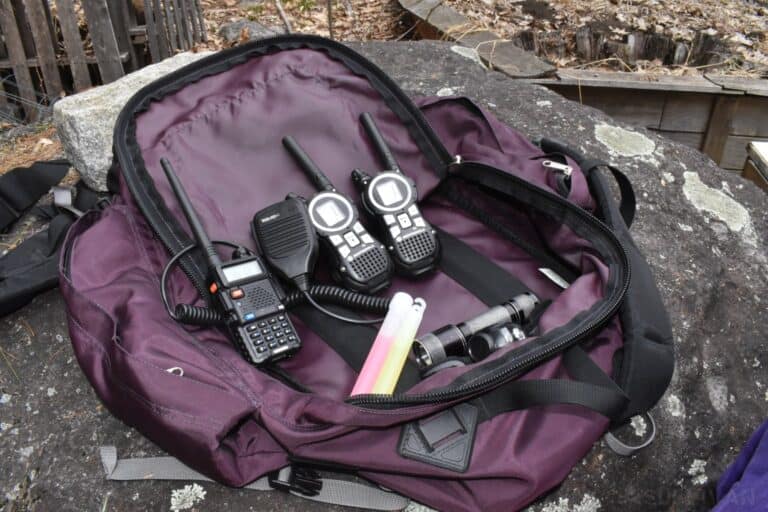
He doesn’t just have a first aid kit, he packed a trauma kit as well, for more serious injuries:
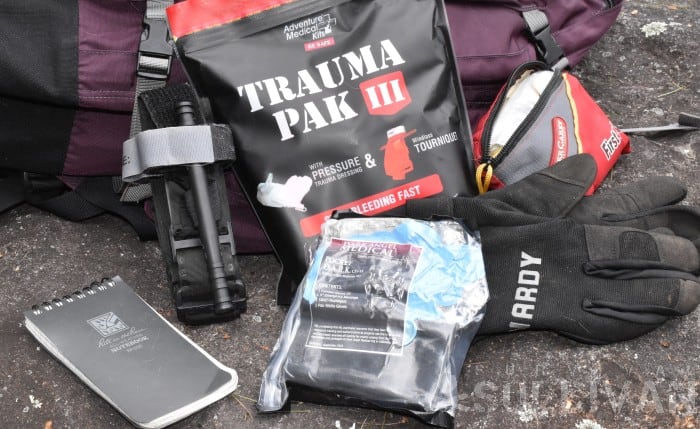
How Many of These Essentials Do You Have?
Is there anything not on this bug-out bag checklist that you think is missing? Maybe something you yourself have packed to cope with your unique situation, whether it’s a medical issue or something else. Let us know in a comment below.
Oh, and don’t forget your PDF checklist that you can save and print from here.
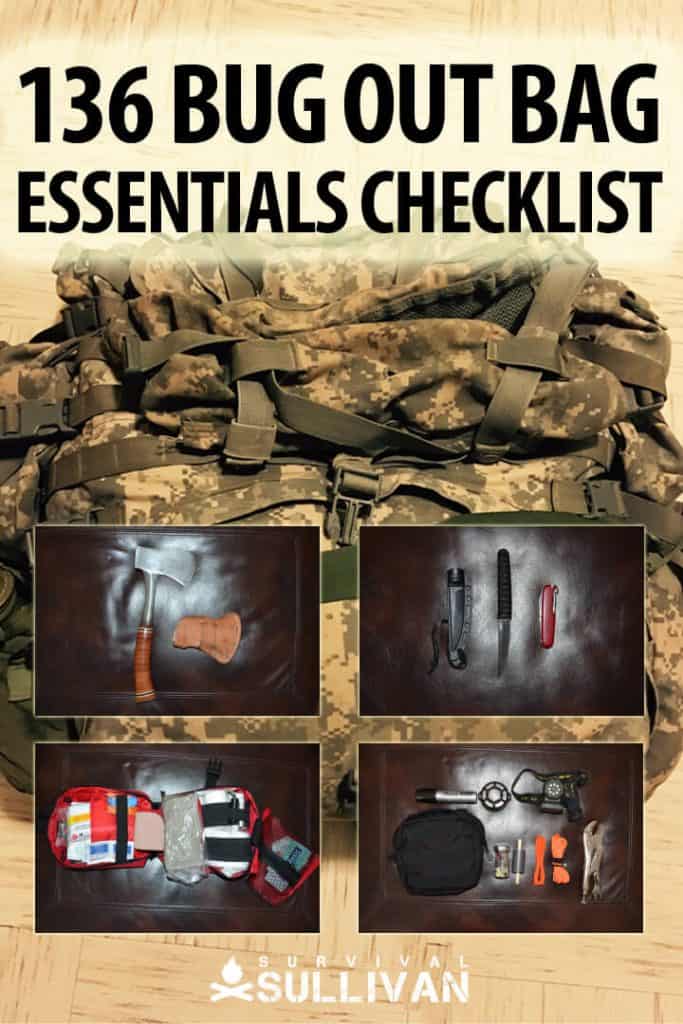

My dad was military. My grandfather was a cop. They served their country well. But I don’t like taking orders. I’m taking matters into my own hands so I’m not just preparing, I’m going to a friggin’ war to provide you the best of the best survival and preparedness content out there.

Hey, can you make a list of the more essential stuff? Because I don’t think anyone can carry all that around. Thanks!
Absolutely.
Useful information. Working on putting this together for 3 people.
Help, my BOB is 65 lbs. I keep reading then adding to my BOB. More of my backpacking gear is moving into my BOB. What are the strategies (criteria) for BOB, 72 hour Bag, vehicle Bag?
More stuff can’t be every answer.
Hey Jay,
You could:
– remove things that are heavy (extra water, canned food, books)
– replace some of your gear with lighter alternatives
– put the rest in your car’s trunk
– or have a second BOB with the non-essential stuff
I hope this helps.
I had the same problem and still a work in progress. First thing I would recommend is looking at ultra light camping gear that should help a lot, second thing would be have test run and see what you used and start getting rid of non essential items that you thought you needed, and my third suggestion would be invest in learning some bush craft skills and you can probably lighten up your bag some! Hope that helps you and would love to hear how you.are making out Good Luck!
Dear Jay B ( 12/06/16 ) Redundancy. The idea of carrying 1 item that can do two jobs lightens your load ( in most cases ). Don’t carry three knives, carry a swiss army knife and a hatchet. Guys in the military use ka bars to open boxes more than they do to open enemy troops. Think about it, if you had a m4, a m9 and a ka bar, which would you use. Some guys also think they need a .22 rifle with a scope to hunt small game. You don’t need a rifle. Get a tricked out .22 pistol. Small game is usually close. Saves some weight and space. Another thing , use your equipment, that is the best way to really know what works and what to get rid of. Good Luck and God bless you.
1) binoculars or monocular
2) Wet-stone or oil-stone or sharpening tool to keep “alive” your knives and cutting tools.
Try to get all of you critical electronics (radios, lights) using common batteries (AA). Also, lithium batteries are considerably lighter than their alkaline counterparts.
Make sure that your stainless steel water bottle is SINGLE walled. A double walled (thermos) style could rupture or explode if placed in a fire when trying to boil water or cook.
Collapsible bowl (rubber or silicon).
Alcohol or mini wood-gas stove. (Small thermal signature while cooking. A campfire draws a lot of attention).
ANSI rated safety glasses or goggles.
Combat gauze. (Kaolin)
If you plan on carrying any important documents, print them out on Write-in-the-Rain paper. (You may need a laser printer to print on Write-in-the-Rain paper)
Good article…keep getting the word out…
How would a double walled stainless cup or thermos explode? Its a vacuum in between the walls not a gas so what’s there to expand?
I don’t know if it would explode, but it certainly is defeating the purpose to try and heat water in the vacuum insulated bottle. The point of the bottle is to insulate the inner contents from the temperature outside. You definitely want a stainless steel (inside and out) non insulated bottle. Kleen Kanteen has some in a variety of sizes. The Backpacker stove referenced in this article requires bottled
fuel that may not be available in an emergency situation – check out the Firebox stove at http://www.Fireboxstove.com. The stove can be used with a little alcohol burner (lots of DIY projects for these), a backpacking stove that uses gas or with wood . The 5″ Firebox has a “boiler ring” that fits nicely around a 40 oz Klean Kanteen. The titanium G2 3″ Nano version only weighs 6 oz and folds down to 1/4 inch thick.
A hat, with brim, wool, one each, with wool scarf, usable in cold and heat. Other clothing as appropriate
What hand crank chainsaw are you referring to? The smallest chainsaw I know of is what is called a climbing saw used to cut small limbs while climbing a tree with spurs to cut it down. Just seems impractical for a bug out bag.
It’s called a pocket saw or saw cable. No motor, you work it back and forth by hand to cut wood.
I’d add 6′ of 1/2″ or 3/4″ hose to use for syphoning gas
Hey Jay, I found the same problem. I had a back surgery in my twenties and now in my sixties it take a lot to tote around a 70 lb. pack. I live in Maine and some of the cold winter weather with wind can make life unpleasant. I work 35 miles from home so my answer to winter is a great heavy duty sled that fits in the trunk that carries several bags of gear. I have pulled it several times with over 100 lbs. of gear. My bags are water proof and the sled has a cover and I use a body safety strap so I can be hands free. For the summer I use a take down deer recovery cart. It has rubber wheels and rated for 250 lbs. It also comes apart and fits in the trunk and can connect to the body harness.
Like you I’m in my 60’s with several back surgeries. Seems to me I could do a lot more(skills) with a lot less (gadgets). I agree 1 is none & two is one. A 35 lb pack & a handgun, rifle and ammunition puts me near 50. I tell folks take your pack on a 5 mile 3 day hike in inclement weather. At the end you will know what you can hump & what you NEED. Love your idea, adding a sled for winter!
Walk fit orthitic insoles @ walkfit.com.
Absolutely the best $20 I ever spent in my life ever.
It takes a painful few days for your feet to get used to the prospect of walking without straining your muscles but after that they just roll… and you can say goodbye to any back, knee of foot pains.
How about cordage?
I have had several heart attacks and surgeries so I can not carry anything heavy. So I allways use a personal shopping cart with good wheels to carry my things when I travel instead of a backpack. It is handy and takes a lot of goodies, even my folding reclining chair for the old man.
Congratulations for your list it is the best one I have read.
All the best.
Cute list, but who would take canned tuna over packaged if you are saving space and weight… only complaint!
Here’s a good one… a Buff.
https://youtu.be/ewVEK-AElDY
Oh and it may take some searching but you can even find them in cammo color schemes
It’s a comprehensive list, I figure if 80% of my needs are met I’m doing pretty good. To get anywhere from where I live I would have to cross a desert, so a lot more water is what I would add. But if I left my rural home people from the city would be here in short order.
I would disagree (slightly) on avoiding MREs…they are heavier than freeze-dried, but can be eaten as is or heated (most now contain heaters), don’t need water (except for a very small amount to activate the heater) and if combined with dried fruits (raisins, etc) the constipation problem can be avoided, plus they have become better of late.
This list is way to much so I’m giving it a 2 star rating. You want to keep things simple and use the less is more concept.
1. Something for shelter if needed. This could be as simple as a rain poncho or light wool blanket.
2. Something to purify water. Water is everywhere. Carrying it is way to heavy. But making it drinkable is crucial. A pocket purifier is what I suggest.
3. A way to make fire. This could be as simple as a lighter or as complex as a flint and steel. The only requirement is that it works for you.
4. A good knife. This will be the most used tool you can carry. Make sure it’s full tang and big enough you can baton with it.
5. Cordage. As simple as a paracord bracelet or a spool of bank line will be good .
This is really all you need and should be the basis of any kit. Of course environment matters. In urban areas shelter will be abundant but a good wool blanket will still come in handy. Water will be plentiful but you would still want to purify it. In an urban environment I would substitute a a water bottle with built in filter over the pocket purifier. In a city you might want a more concealable knife but would have to be aware of the laws surrounding its carry.
The point is to keep it simple. To much will just be a waste.
Where is the absolute essentials list? This is WAAAAAY too much for most people.
http://www.survivalsullivan.com/bug-out-bag-essentials-shortlist/
Always make that soap on any list ‘hard milled” Lasts forever! where as the soft stuff is gone so quickly. 1 bar will go a month or more for a family of five!
This list is based on what you can pick. Not everyone has the skills to use everything listed. Instead of making a comment about too much how about helping people understand more on what they should use.
Toilet paper Vs Flushable Wipes – Army for 28 Years (Abn/Ranger Infantry/Aviation -160th) Scouting for 15+ – Drop the Toilet Paper (TP) and go with Flushable Wipes. 30- 40 flushable wipes fit in a snack zip lock bag and in your pocket – a few more bags in your backpack or go bag, and a few more in the car. Always accessible. Even in a bag – once wet – TP is useless forever. The worst that can happen to flushable wipes is that they dry out – an ounce of water in the bag (even if the bag has a hole) will re-hydrate them for immediate use. Finally, wipes just do a better job than (even dry/soft) TP.
Where can I
get a Buff ? Very practical…..
Amazon has them, a variety of colors and patterns 6 or 9 for $9.99.
Two suggestions: (1) Compact religious book such as Bible, Quran, etc for emotional comfort and a place to find prayers should, God forbid, you have to bury someone and (2) hand, foot, and body warmers in late fall and winter. A ground pad helps a lot on top of tent floor or tarp but depending on your physical condition and age.
I am not a knife authority or expert by any criteria. I have carried and used knives for over 65 years now, and own several hundred from all the major brands, and a dozen bench made or private made knives, including some by Jimmy Lile. I have some opinions about knives I would like to pass along. First, almost all name brand knives, Buck, Gerber, Case, Kershaw, Schrade, Swiss Army, etc. are good workable knives. My personal choice is the Schrade brand for quality at a very reasonable cost.
Pocket Knives:
I have carried and used the Schrade Old Timer 8OT Senior Stockman for over 50 years as my knife of choice. It is currently selling for $17.81 on Amazon. Remember 50 years ago Tactical knives didn’t exist. I also like and carry if needed the Swiss Army Tinker knife.
Fixed Blade Knives:
I have and use a Schrade Uncle Henry Bowie knife as my large camp knife. It lists for around $42.00 but is on sale for $26.00 often. For hunting and dressing field game I have a Schrade Old Timer 15OT Deerslayer with a Sure Grip Handle and Leather Sheath. I purchased this sometime in the 1960’s, and still use it when required. I like my KA-BAR Leather Handled Hunters knife but would replace it with a Micarta handle knife for a survival situation. If I were to be limited to only one fixed blade knife I would select a knife similar to the ONRAT7: RAT-7 Survival Knife by the Ontario Knife Company or the KA-BAR 1282 D2 Extreme Fighting Knife 7″ Combo Blade, Kraton G Handle, Kydex Sheath
Tactical Knives:
My tactical knife of choice is a Spyderco Military Folding Knife. I have two that I use interchangeably, one with a stainless steel handle, which makes it hard to handle with bloody hands. The other is a fancy handle made from turquoise, and abalone shell and my name engraved on it. Another Spyderco knife has a Micarta handle and 4-inch lock-back blade. I don’t remember the model or number of the knife. I have and use two different Schrade Tactical knives, one with a drop point, and the other with a Tanto point. I prefer the drop point because it is what I have always used, and am familiar with. The drop point knife also has a thicker blade, better lock, and handle, making it the heaviest and thickest of my tactical knives.
Would pemmican also be a more portable food? It could maybe take a few pounds off and like hardtack, it lasts a long time.
I keep a sharpening stone in my BOB. A dull knife or hatchet is not worth much if it can’t do it’s job. I like the small round two sided stones that you can get from multiple knife companies.
Hello,
You put an enormous amount of stuff in there, more than I could read, for only 72 hours. If I may add a thought on this …
Water: naturally you will have to drink within 72 hours, but not necessarily within the first 5 to 10 hours. If you get thirsty, you aren’t dying yet. You don’t need to sip on a straw, much too complex, that thing is not multi-purpose. It will be very good to have a filter system and heading to some place with water, and some emergency water, maybe even 2-3 liter maximum. You do not need a cup of any kind, waste of weight. Stainless steel is heavy, for an emergency travel the lighter the better, like whatever plastic bottle(s).
Sleeping: sleeping bag and bivak sack should do, with mat. I definitely would carry at least one thin inflatable mat, if possible two. I really do not like laying hard, may just be me though. A tent is quickly very heavy, avoid when possible if 72 hours is the goal, so you could use a tarp setup. I have had fun “sleeping” under a tarp and basic bivak sack in storm + rain. There are also bivak sacks now that double as a miniscule tent for head area. Since I have that too I will use that, it is 1.5 kg or so. I have to admit though that if weather is bad a bit more roomy tent will be very good for comfort, especially when it is cold / wet.
Clothes: irrelevant for 72 hours. Whatever you are wearing will do, or whatever seems ok to you. No need to wash while walking outside. Nobody cares if you stink when the nukes have impacted, nobody cares about a stain on your shirt when the stores are empty, and you will note even stink that much because you are outside in the wind.
Hygiene: You can use a sock and whatever water to freshen up. Rub well ! You will get clean, soap and other luxury items are wasted weight. Two pair means you have two washing hands for free. Personally I might still want to carry a toothbrush along, though ! lol Modest towel could be useful, or use a second T-shirt that is also a towel, and a hat, and a cushion, and who knows what else (bandages, bag, etc). I mean you can use it as that too.
Shoes: irrelevant also for 72 hours. This is only a few days ! Its nothing, unless maybe you want to travel a huge distance on hard terrain rather than reach 10 km outside the city to escape a detonation.
Rain gear probably not needed because you can use a tarp if you really need to, which has other uses. Coat depending on weather. Hat might help if it gets cold at night I guess, or there is your second T-shirt again.
Fire: very important to carry this I would think, also because while only carrying the above you have the weight free to do it. Light weight cooking utensils of course. Fire does help the mood so much, it is worth it I think, and you can eat/drink something warm.
The rest of the available weight: food. Food will probably dictate how long you can stay out, or if it runs out it will become the pre-occupation and thus you may no longer be able to travel far in a certain direction because you need to find food. In terms of food I would always go for centuries old known things like flour, rice, butter, cooking oil. You can knit a dough with that and make a basic pancake, do not even technically need a pan for it. Above such basics, whatever seems handy. Some sauce would lift the mood a lot for sure.
Weapons if you want / need I guess, but most of them aren’t very light.
Electronics: nothing, except a flashlight. Don’t even need a watch I suppose, although wearing one wouldn’t hurt much either.
Compass / map might be helpful.
Medication: no unless you certainly would die without it like being a diabetic ? Painkillers: I guess not, although this is so weightless you could add it because it costs next to nothing. It is a luxury item though. How often do you really get hurt so bad you need painkillers ? Once every 5 years or 10 ? You don’t die from pain. More stuff is more complexity and weight.
Medical aide stuff: I guess not either. Unless you expect ten thousand wounded to stream from the city later, then you should probably pack that even above your tent because you can find a building in the country side maybe and help the wounded. Who knows how things go, and that might be the point of packing a ‘Bugging Out Bag’ that is really the true minimum for 72 hours, because once you have that it is simple enough so that you can think straight in the time of pressure, throw some things out or add to it because the weight allows that.
Blanket: I guess maybe, blankets are really one of those items that you forget but wish you had when it gets really cold. But it needs to be a light one. You often hear about blankets when it is an disaster somewhere, right ? A blanket is lots of things too: its a towel, its a coat, its a sleeping mat, its a tent, its a bag …
I think that is quite a decent pack for 72 hours in a disaster evacuation. The less weight, the further you can travel on foot. Best of luck.
P.S. Its not bad that the original article is a big list, though, because that way lots and lots of things we can think about if it would fit our need. In reality I would go for something much less if I had to run off on foot with a view of surviving a few days. I hope you can see this as we trying to help each other with our thoughts. Will check your list in detail later, thanks.
I agree not all of the items are important for everyone, but I would highly recommend you think beyond 72 hours. large-scale disasters will last much longer than that, your bug out journey could go wrong, and even if it doesn’t, you could still use these items after you reach your destination. But really, expect to survive off your BOB for at least a week.
I agree that the list is a START. It’s an overview of items which may be important in your given situation. With that in mind, we each need to evaluate our personal situations, possible reasons for bugout, and have plans A, B and C formulated and practiced. Some situations may actually recommend bunkering in place. Others may require immediate, high speed relocation of one’s self and family members. Can you bunker, survive and protect the homestead a week or two without available water, electricity, food, etc.? If running is necessary … where to? by what means? Preplanning on an individual or family unit basis is paramount. Ultimately, preplanning and the reason for bugout is what determines the contents of any prepper stash.
I consider the first aid kit one item with a lot of components; once they are packed in a case/tackle box it is one thing to carry. And if you are carrying a heavy pack or a baby or toddler, I assure you that you will be happy for some Ibuprofen or Tylenol at the end of the day.
Remember a 72hr kit is a minimum; depending on what kind of emergencies are common in your area you may need more; last summer with the forest fires we were told to be ready for 7 days if we were told to evacuate.
Depending on the makeup of your family, some things can be spread among the other family members or they will carry their own. Since you are bugging out, some things can live in your vehicle if they won’t be affected by changing temps.
HTH
Maybe what you suggest is good, but I disagree with the clothing part. You can become very sick walking in wet clothing, never mind the blisters and sores from wearing wet clothing. The rain gear will most likely not take up too much space, and at the VERY least you will need several pair of socks to keep your feet dry. No, it’s not necessary to have a clean set of clothes for every day, but at least one or two changes if the weather gets bad is a good idea. Hey, you could even wear all of it to help save space and weight.
People leaving comments here have lamented, some times at length, about how long these lists of supplies are. I, for one, am VERY THANKFUL, for every last suggestion the author included. I’ve been looking for an article like this where suggestions for the best of the best are included. I knew from the start, as I’m sure most peope do, that I couldn’t possibly include everything on the list. My choice will be, as everyone’s choice will be, to pick those items each of us are currently familar with, or are willing to learn. So PLEASE, I ask those who are more that familar with all of these items, to kindly understand that some of use are here to learn. I, for one, DO NOT, want to be among those hords that will be roaming the cities and countryside looking for food and supplies they were too cheap or lazy to get themselves. JUST SOMETHING TO THINK ABOUT.
I totally agree! This list actually helped me to reassess my own kit to make it more efficient. Thank you, Dan!
Great article! I’d include a small Bible. In a crisis situation this would make a huge difference for my morale. Seeds. Strapping on the frame and wheels of a lightweight ‘trolley bag’ to pull along a backpack when practical could make a difference for those who are less robust. A list of contacts for loved ones.
At a local preparedness fair, someone noted that I was using a rollator (rolling walker) and suggested that I make a bag for my walker. I have a string backpack that was a giveaway from some business that has reflectors on it but is basically very unassuming. I keep it packed and it stays on the walker (I periodically replace food items). I also have photographers vest that holds a decent amount of small light weight items. With those plus my EDC purse, I have a decent start on that list and not a lot of weight to carry. Heavy stuff is in a carryon size rolling suitcase. I plan to add some telescoping walking poles for if I have to go on more rugged terrain; I won’t have a seat like the walker but they would help with support and balance.
Thanks for educating us 🙂
Also, about not taking a lantern, I have some that are very lightweight plastic/rubber that fold flat and you pull them up to light. They are clear but also have the light changing feature (I don’t particularly like it, but it’s there…) Solar generated, so no battery, just daylight.
I really appreciate this list. I couldn’t carry that much but, the impression I get, it’s a comprehensive list that gives you plenty of ideas, & you choose what you think you might want/need.
Years ago, my 70 yo, marine, great uncle went fishing by himself. It was cool & had rained. He had a bag of waxed matches & that was it. His boat capsized & he had to stay out overnight in the woods by the lake. He dried the leaves on his shirt to start a fire & spent the night with no shelter, no food, but could get water from the lake. It was only for about 24 hours, so not that big of a deal, but those matches were all he needed. Of course he would’ve needed something to hunt with or fish with if he was there longer but you can make do with what you have. Some of us need much more than others, I have health issues that require meds & I have about a month’s worth in my pack. I have an expansive trauma pack with bleed stop & all manner of bandages. I’m more paranoid than the rest of my family so they can help carry my packs & just grab them some clothes because they don’t have packs prepared.
I don’t have a lot of $ so I appreciate the suggestions of where to get what for reasonable prices.
I think the author was making a very comprehensive list & you choose what you want out of the list. So thanks for the list & thanks for the other suggestions, they’re extremely helpful.